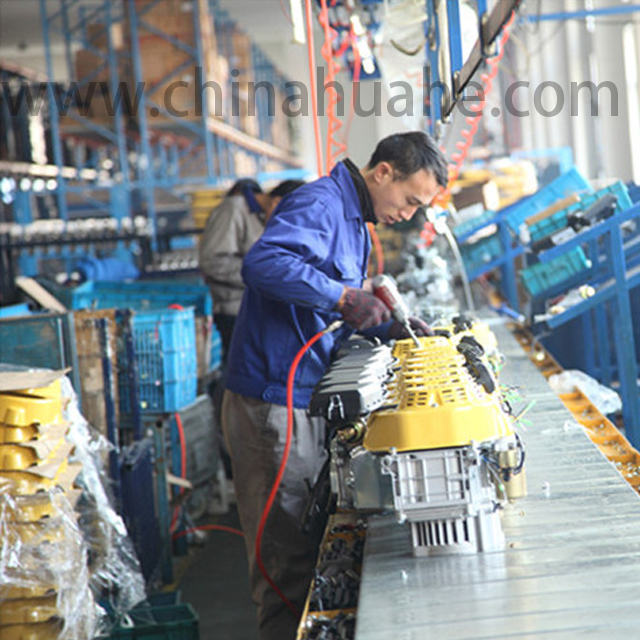HH6500
HuaHe
Product Type:Spare Parts of Gasoline Generator
Model:HH6500
Product Name: crankcase cover
Usage:Gasoline Generator
Packing:Customized
Certificate:ISO9001
The crankcase of a gasoline generator is an essential component of the engine that houses the crankshaft, connecting rods, and other internal moving parts. It serves multiple functions and plays a crucial role in the overall operation of the generator. Here are some key points about the crankcase:
1. Function: The primary function of the crankcase is to enclose and protect the engine's rotating and reciprocating components, such as the crankshaft and connecting rods. It contains the lubricating oil that provides necessary lubrication to these parts, reducing friction and wear. Additionally, the crankcase helps to seal the combustion chamber, preventing the leakage of gases and ensuring efficient combustion.
2. Design: The crankcase is typically a sturdy, metal housing that is bolted to the engine block. It is designed to withstand the forces generated by the reciprocating and rotating motion of the engine's internal components. The crankcase is often equipped with various openings, such as oil fill and drain ports, ventilation ports, and access points for maintenance and inspection.
3. Lubrication: The crankcase holds the engine's lubricating oil, which is circulated throughout the engine to reduce friction and dissipate heat. The oil is typically stored in an oil pan or reservoir located at the bottom of the crankcase. It is drawn up by the oil pump and distributed to the engine's moving parts through oil passages and channels.
4. Maintenance: Regular maintenance of the crankcase is important to ensure proper lubrication and prevent engine damage. This includes checking the oil level and quality, changing the oil at recommended intervals, and inspecting the crankcase for any signs of leaks or damage. It is crucial to follow the manufacturer's guidelines and use the recommended oil type and viscosity for the specific generator model.
5. Ventilation: The crankcase is often equipped with a ventilation system to allow the release of gases and pressure buildup inside the engine. This helps to maintain a proper balance of internal pressure and prevent the accumulation of harmful gases or contaminants. The ventilation system may include a breather tube, PCV (Positive Crankcase Ventilation) valve, or other components.
6. Replacement: In the event of severe damage or wear, the crankcase may need to be replaced. However, crankcase replacement is a complex task and often requires professional expertise. It is recommended to consult the generator's user manual or contact the manufacturer for guidance on the specific replacement procedure and compatible parts.
In summary, the crankcase of a gasoline generator is a vital component that houses the engine's rotating and reciprocating parts, provides lubrication, and seals the combustion chamber. Regular maintenance and proper care of the crankcase are crucial for the generator's performance and longevity.
First, Introduction
In the work of gasoline generator, crankshaft, as a key internal component, assumes extremely important functions. Its role and characteristics have a profound impact on the overall performance of the engine. In this paper, the structure, working principle and importance of gasoline generator crankshaft will be analyzed in detail.
Second, the basic structure and working principle of crankshaft
1. Basic structure of crankshaft
The crankshaft is mainly composed of crank, connecting rod and spindle neck. The crank is the main part of the crankshaft, which is converted to rotating motion by reciprocating motion of the piston. The connecting rod connects the crank and the piston, converting the linear motion of the piston into the rotating motion of the crankshaft. The spindle neck is the position where the crankshaft is supported in the rest of the generator set, so that the engine can run stably.
2. Working principle of crankshaft
The crankshaft of the gasoline generator is driven by the combustion of the fuel and the pressure change of the gas. In the process of gasoline combustion, the piston moves up and down in the cylinder, and the energy of this movement is converted into the rotating motion of the crankshaft by the connecting rod. This rotating motion then drives a generator to generate electricity through a gear or other transmission.
Third, Characteristics and importance of crankshaft
1. Characteristics of crankshaft
The design and manufacture of crankshafts need to take into account many factors such as strength, durability, balance and lubricity. Because it needs to withstand huge pressure and friction, it needs to have extremely high strength and durability. At the same time, in order to ensure the smooth operation of the engine, the crankshaft also needs to have a good balance. In addition, in order to reduce friction and wear, the crankshaft needs to be well lubricated.
2. The importance of crankshaft
As one of the core components of the engine, the importance of the crankshaft is self-evident. First of all, the quality of its design and manufacture directly affects the performance and life of the engine. Second, the crankshaft plays a key role in the energy conversion process, converting the linear motion of the piston into rotational motion, which drives the generator to generate electricity. Finally, because it is under great pressure and friction, it needs to have good strength, durability and lubricity to ensure the stable operation of the engine.
Fourth,Maintenance and maintenance of crankshaft
In order to ensure the normal operation of gasoline generators and extend their service life, it is necessary to carry out regular maintenance and maintenance of the crankshaft. This includes regular inspection of the crankshaft for wear, cleaning and lubrication. If the crankshaft is found to be worn or damaged, it should be repaired or replaced in time. In addition, in order to maintain the good running condition of the engine, it is also necessary to carry out regular maintenance and maintenance of the engine.
Fifth,Conclusion
To sum up, the crankshaft of the gasoline generator is an extremely important component, which undertakes key functions such as energy conversion and driving the generator to generate electricity. The quality of its design and manufacture directly affects the performance and life of the engine. Therefore, the maintenance and maintenance of the crankshaft is an important measure to ensure the normal operation of the engine and extend the service life. In the future, with the development and progress of science and technology, we expect that more efficient, more durable and more environmentally friendly crankshafts will be developed to provide better support for the development of gasoline generators.

Advantages
1.100% testing with loaded before packing.
2.With ISO9001 certification.
3.Reasonable price with higher quality.




Product Type:Spare Parts of Gasoline Generator
Model:HH6500
Product Name: crankcase cover
Usage:Gasoline Generator
Packing:Customized
Certificate:ISO9001
The crankcase of a gasoline generator is an essential component of the engine that houses the crankshaft, connecting rods, and other internal moving parts. It serves multiple functions and plays a crucial role in the overall operation of the generator. Here are some key points about the crankcase:
1. Function: The primary function of the crankcase is to enclose and protect the engine's rotating and reciprocating components, such as the crankshaft and connecting rods. It contains the lubricating oil that provides necessary lubrication to these parts, reducing friction and wear. Additionally, the crankcase helps to seal the combustion chamber, preventing the leakage of gases and ensuring efficient combustion.
2. Design: The crankcase is typically a sturdy, metal housing that is bolted to the engine block. It is designed to withstand the forces generated by the reciprocating and rotating motion of the engine's internal components. The crankcase is often equipped with various openings, such as oil fill and drain ports, ventilation ports, and access points for maintenance and inspection.
3. Lubrication: The crankcase holds the engine's lubricating oil, which is circulated throughout the engine to reduce friction and dissipate heat. The oil is typically stored in an oil pan or reservoir located at the bottom of the crankcase. It is drawn up by the oil pump and distributed to the engine's moving parts through oil passages and channels.
4. Maintenance: Regular maintenance of the crankcase is important to ensure proper lubrication and prevent engine damage. This includes checking the oil level and quality, changing the oil at recommended intervals, and inspecting the crankcase for any signs of leaks or damage. It is crucial to follow the manufacturer's guidelines and use the recommended oil type and viscosity for the specific generator model.
5. Ventilation: The crankcase is often equipped with a ventilation system to allow the release of gases and pressure buildup inside the engine. This helps to maintain a proper balance of internal pressure and prevent the accumulation of harmful gases or contaminants. The ventilation system may include a breather tube, PCV (Positive Crankcase Ventilation) valve, or other components.
6. Replacement: In the event of severe damage or wear, the crankcase may need to be replaced. However, crankcase replacement is a complex task and often requires professional expertise. It is recommended to consult the generator's user manual or contact the manufacturer for guidance on the specific replacement procedure and compatible parts.
In summary, the crankcase of a gasoline generator is a vital component that houses the engine's rotating and reciprocating parts, provides lubrication, and seals the combustion chamber. Regular maintenance and proper care of the crankcase are crucial for the generator's performance and longevity.
First, Introduction
In the work of gasoline generator, crankshaft, as a key internal component, assumes extremely important functions. Its role and characteristics have a profound impact on the overall performance of the engine. In this paper, the structure, working principle and importance of gasoline generator crankshaft will be analyzed in detail.
Second, the basic structure and working principle of crankshaft
1. Basic structure of crankshaft
The crankshaft is mainly composed of crank, connecting rod and spindle neck. The crank is the main part of the crankshaft, which is converted to rotating motion by reciprocating motion of the piston. The connecting rod connects the crank and the piston, converting the linear motion of the piston into the rotating motion of the crankshaft. The spindle neck is the position where the crankshaft is supported in the rest of the generator set, so that the engine can run stably.
2. Working principle of crankshaft
The crankshaft of the gasoline generator is driven by the combustion of the fuel and the pressure change of the gas. In the process of gasoline combustion, the piston moves up and down in the cylinder, and the energy of this movement is converted into the rotating motion of the crankshaft by the connecting rod. This rotating motion then drives a generator to generate electricity through a gear or other transmission.
Third, Characteristics and importance of crankshaft
1. Characteristics of crankshaft
The design and manufacture of crankshafts need to take into account many factors such as strength, durability, balance and lubricity. Because it needs to withstand huge pressure and friction, it needs to have extremely high strength and durability. At the same time, in order to ensure the smooth operation of the engine, the crankshaft also needs to have a good balance. In addition, in order to reduce friction and wear, the crankshaft needs to be well lubricated.
2. The importance of crankshaft
As one of the core components of the engine, the importance of the crankshaft is self-evident. First of all, the quality of its design and manufacture directly affects the performance and life of the engine. Second, the crankshaft plays a key role in the energy conversion process, converting the linear motion of the piston into rotational motion, which drives the generator to generate electricity. Finally, because it is under great pressure and friction, it needs to have good strength, durability and lubricity to ensure the stable operation of the engine.
Fourth,Maintenance and maintenance of crankshaft
In order to ensure the normal operation of gasoline generators and extend their service life, it is necessary to carry out regular maintenance and maintenance of the crankshaft. This includes regular inspection of the crankshaft for wear, cleaning and lubrication. If the crankshaft is found to be worn or damaged, it should be repaired or replaced in time. In addition, in order to maintain the good running condition of the engine, it is also necessary to carry out regular maintenance and maintenance of the engine.
Fifth,Conclusion
To sum up, the crankshaft of the gasoline generator is an extremely important component, which undertakes key functions such as energy conversion and driving the generator to generate electricity. The quality of its design and manufacture directly affects the performance and life of the engine. Therefore, the maintenance and maintenance of the crankshaft is an important measure to ensure the normal operation of the engine and extend the service life. In the future, with the development and progress of science and technology, we expect that more efficient, more durable and more environmentally friendly crankshafts will be developed to provide better support for the development of gasoline generators.

Advantages
1.100% testing with loaded before packing.
2.With ISO9001 certification.
3.Reasonable price with higher quality.




